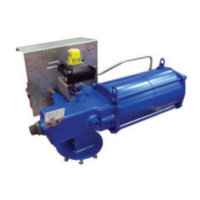2
RPS SPRING RETURN PNEUMATIC ACTUATOR
INSTALLATION, OPERATION AND MAINTENANCE MANUAL
1.4 Technical data
1.3 Introducing the actuator
RPS actuators are pneumatic low-pressure
spring return, suitable for any quarter turn
application such as ball, plug, butterfly valves
or dampers, in both ON-OFF and modulating
heavy-duty service.
The actuator is made up of a rack and pinion
mechanism, which transforms the linear
movement of the pneumatic cylinder, in one
direction, and of the spring, in the opposite
direction, into the rotary movement for the
valve operation. An adjustable bronze sliding
block supports the transverse force exerted on
the rack by its engagement with the pinion. The
rack is nitride for ensure the minimal friction.
The spring module incorporates one or two
springs in series, depending on the model,
and is fully encapsulated. This assures safety
to personnel and ease of assembly. External
travel stops allow precise angular stroke
adjustment between 80° and 100°.
Totally enclosed, weatherproof housing, made
of nodular cast iron for maximum strength and
suitable for use in hostile environments.
The mounting flange is identical on both
(upperand lower) faces of the housing; the
shaft output drives have the same dimensions
but is positioned at 90°. This allows the
actuator to be used as spring to close or spring
to open without modification.
The actuator is assembled onto the valve by
connecting the actuator housing flange to the
valve flange by a spool piece and the actuator
shaft to the valve stem by a stem extension.
Supply fluid Air, nitrogen or sweet gas
Operating
temperature
Standard: from -30°C to +100°C
Optional: from -60° to +140°C
Design pressure 12 bar maximum
Supply pressure Please refer to technical data
sheet
Output torque Up to 3700 Nm
1.2 Identification plate
It is forbidden to modify the information and the
marks without previous written authorization
by Biffi.
The plate fastened on the actuator contains the
following information (figure 1).
FIGURE 1
Data plate
Actuator manual emergency operation in
opposition to the spring action, is performed
by rotating the jackscrew by a wrench or by a
handwheel (available on request).
The mounting flange, on the housing top, can
be utilized for the assembly of limit switches,
position transmitter, positioner etc., which are
actuated by the actuator output shaft.
The actuator housing is provided, on the front
face and in the back face (optional), with
threaded holes for the assembly of accessories
(control panels, air storage tank, etc.).
The expected lifetime of actuator is
approximately 30 years.

